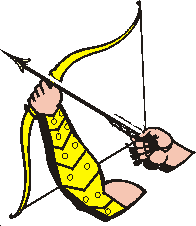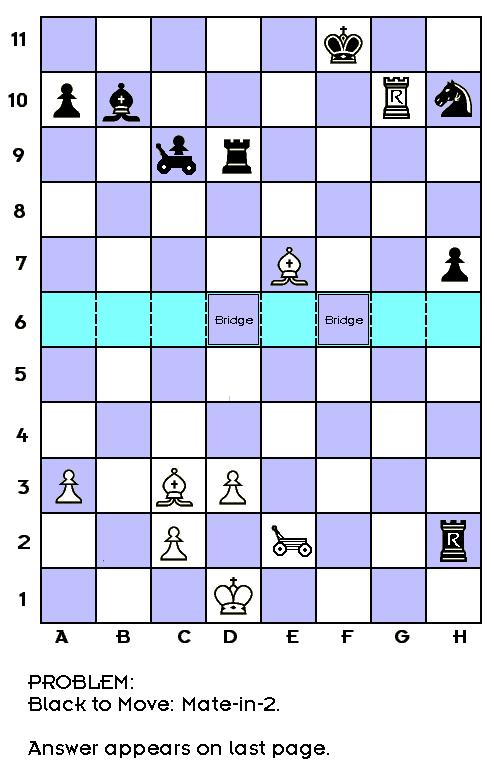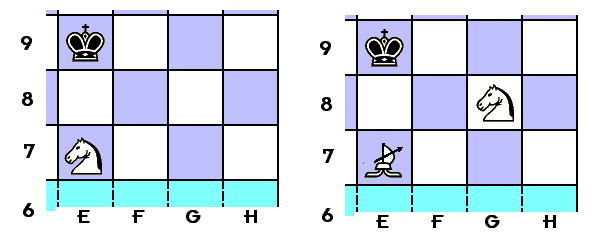


by Gary K. Gifford, © 2003
This document provides the rules for Catapults of Troy and includes a problem
from the first checkmate to be seen in this game. After reading the rules, can
you find the mate-in-2? In addition to the rules and the problem, I have
including a few diagrams to help explain some of the unique movement options.
Catapults of Troy was conceived during a bicycle ride one evening in November of 2003. During the ride, while in sight of Lake Erie, I was thinking about Chinese Chess and its virtual river, which exists only for appearance sake. But I thought, "What if the river was an actual barrier? We would want bridges and bridge builders. I also thought of the impressive Chinese Chess piece, the Cannon which launches itself. And I thought, what if there was a piece that launched other pieces? A Catapult that could toss, not itself, but other pieces across the river? Or to other parts of the board? And what if the Horse was based on the wooden horse from the Legend of Troy? What could we put inside this Troy Horse? How about an Archer? When I arrived home I quickly sketched the game, made a paper set, and wrote down the rules.
|
|
|
|||
|
Acknowledgement and appreciation is given to Armando H. Marroquin for use of his "Chess Adventurer" free ware font from which I used his rather unique Bishop as the Bridge Builder and his Knight as the Troy Horse; and to Eric Bentzen for his "Chess Alpha" free ware font from which I used the Bishop, Rook, King, and Pawn. I created the Archer, Ram, Catapult, and Bridges, which others may freely use. I would also like to thank the Corel Corporation for the use of Corel Draw in making my very first pieces, 5 of which appear in this document. And last but not least, a special thanks to Tony Quintanilla for his gaming comments, pre-testing, and move courier pre-set development. And, of course, to ChessVariants.com for maintaining a great archive of amazing playable strategy games.
|
||||
|
Piece |
Comments |
|||
|
Bridge
|
8 Bridges can be used, one for each square on the River, i.e., A6 through H6. Theses Bridges do not belong to either player and can be considered as squares that can be added to [or removed from] the board, thus revealing the river when not in place. It is the Bridge Builder piece that adds or removes bridges. A piece is allowed to end its turn on a Bridge. Bridges cannot move. In the following diagram we see a Bridge at G6. |
|||
|
|
It was placed there by the Bridge Builder at H7. In this position the following pieces could use the Bridge: In this position, if it were Blacks move, the Bridge Builder could (a) remove the Bridge from G6, (b) move onto that Bridge, (c) add a Bridge to H6, or (d) move to H8 or G7. Note: In this Diagram the Bishop on C6 is on a Bridge; therefore if the Bishop moves off of C6 we would place a Bridge piece there. It would also be acceptable to show a double image of Bridge and Bishop but that method is more labor intensive to diagram making. |
|||
|
Bridge Builder
|
1 per side. Start on d1 and d11. Moves and captures in the manner of
the King. When on a square adjacent to the river, the Bridge Builder may
place a Bridge piece onto a river square. The Bridge can be place directly
in front of the Bridge Builder, or on a forward diagonal square. On
subsequent turns, additional Bridges can be built. Bridge Builders can
remove bridges (regardless of who built them). The river can be crossed at
points where bridges exist without use of a Catapult. Pieces can move onto
a bridge. For notation purposes, the building of a Bridge on G6 on blacks
10th move could look like this: |
|||
|
Catapult
|
1 per side. Start on b1 and b11. Catapults move like rooks, but
cannot
make a capture. They are used to launch pieces across the river or to
other areas of the board. Catapults have the following types of moves: 2) Move with a piece mounted to it. 3) Launch a piece to a vacant square or vacant bridge. 4) Allow one of their same color pieces to make a normal move onto the Catapult. 5) Allow one of their same color pieces to move off of the Catapult. Note: Loaded Catapults are captured as though they were one piece. Not a pleasant prospect for the victim of such a capture. |
Set of 1 unloaded and 8 Loaded Catapults. |
||
|
|
Sticking with the same board position, The Black Catapult (on E8) could pick up: the Black Ram, or Black King, or Black Pawn (C8). It could stay on E8 and allow the Ram or Bishop to move onto it. It could, instead of one of these options, move to E7, E9, E10, D8, or F8. The White Catapult (on E4) is loaded with an Archer. It could move with the Archer onboard. Or, it could move and leave the Archer at E4 and stop under the Ram at G4 or under the Pawn at A4. It could "launch" the Archer to a vacant square: to E9 would put the Black King in Check. It could launch the Archer backwards to E2, or sideways to H4, for example. The White Catapult could stay at E4 and allow the Archer to move off of it. The Archer could, for example, move onto the Bridge at C6 (thus capturing the Bishop). Or, the Archer could "shoot" its arrow while on the Catapult, thus hitting the Bishop and removing it from the board (if that happened wed place a Bridge piece at C6). |
|||
|
Ram
|
Starts on H1 and H11. The Ram moves like a Rook, but when it captures it cuts through the entire rank or file that lies before it. It must also capture pieces of its own color if they are in the chosen line of fire . However, the first piece that is to be captured must always be the opponents piece. Once a Ram has completed a move involving captures, the Ram is considered to be "splintered" and must be removed from the board. Rams can be catapulted across the river, or can make use of a bridge. In the preceding diagram the Black Ram on G8 could move across the G6 Bridge and down to G1, capturing 4 pieces at once. The Black Ram would then be removed due to the "splinter effect." Could the Ram have stopped on G2? No the Ram must complete its move through the Rank or File in the direction of capture [so make sure your own pieces are out of the way because the Ram will also destroy them!]. Note: In the preceding figure, if the Bridge Builder was in front of the Ram the Ram could not make the G8-G1 move because it cannot destroy its own piece first. If, in the preceding position we made the G1 Troy Horse Black, the Ram could still make his deadly move, but the G1 Troy Horse of same color would also be a victim. |
|
Bishop
|
2 per side. Start on c1, f1 and c11, f11. Moves like a conventional Bishop. The Bishops cannot cross the river unless (a) catapulted or (b) they have a bridge available which completes the diagonal that they wish to move along. Note that you can obtain two light-square or two dark-square Bishops by use of the catapult. In the previous position the Black Bishop could capture the Pawn on A4. What about the White Catapult/Archer? Yes, the Black Bishop could take the "combo-piece" as if it were one piece. |
|
Rook
|
Start on A1 and A11. Moves and captures in the manner of a conventional chess rook. Like other pieces, rooks can be catapulted across the river. There is no castling. |
|
Pawn
|
Pawns start on the second rank for each side but are not placed on b2, g2 or b10, g10. They move and capture as do conventional chess pawns, with these exceptions: a) Movement is limited to 1 square at a time (unless the pawn is being catapulted) b) there is no pawn en passant, c) upon reaching the last rank, a Pawn is immediately promoted to an Archer. And note that Pawns can be catapulted straight to the last Rank. They could also be catapulted to the left or to the right. You could catapult a Pawn from A2 to B2 or to G2, for example even though B2 and G2 normally have no pawns. |
|
Troy Horse
(starts carrying |
1 per side. Starts on g1 and g11. Troy Horses move like a standard chess knight. However, these horses are more powerful as they carry an Archer within their wooden frame. Troy Horses can jump over the river, or be catapulted across it. To cross the river on its own, a Troy Horse on F5 could move to E7 or to G7. A Troy Horse can land on a bridge, but never in the river. After having landed on the opponents side of the river the Troy Horse, on a future move has the option of moving and [at the same time] leaving an Archer on the square it vacated as indicated in the following figure. The Troy Horse is limited to 1 Archer. Horses can never retrieve an Archer. |
|
|
|
|
Archer
(Pawns promote to Archers) |
Archers are not seen at the beginning of the game because they come from either a Troy Horse (each Horse holds one Archer) or from the promotion of a Pawn when the later reaches the last rank. An Archer can emerge from the Troy Horse only after the Horse has crossed the river, and only on a subsequent move (see Troy Horse for example figure). When the Troy Horse moves from within the enemy territory, simply place the Archer where the Horse was at the beginning of that turn. The Archer has two types of moves. (a) Moves like a chess queen, but is limited to no more than 2 spaces. (b) stays at its current location, but shoots an arrow up to 2 spaces. They can shoot over the river, a river square counts as one space. The Archers arrow will hit the first target in the line of sight. In other words, you cannot shoot over pieces to hit other pieces behind them. Pawns only promote to Archers. Whenever an Archer captures by shooting, the Archer does not move. The shoot counts as a turn. Example of a few possible Archer captures on Whites move 20 from the following partial board position.
Also note that the Catapult on C8 could catapult the Pawn to C11, resulting in a Pawn promotion to Archer at C11. Giving check to the King. |
|
|
|
|
King
|
1 per side. Start on e1 and e11. Moves like a conventional chess king. There is no castling. The game ends when the King is checkmated. Kings can be transported and can be projected by Catapult. |
Additional Information:
- Sample game: To be added.
- Solution to Mate-in-2; Black to move (problem is shown on page 1)
1 Ram-H1 + Check
2. K-D2 [forced] Ram checks cannot be blocked.
2. . C9-C1 # The Pawn catapults and promotes to Archer instant Mate.











